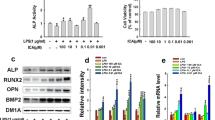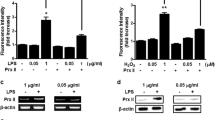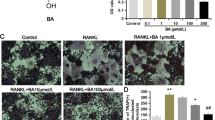Abstract
Bone degradation is a serious complication of chronic inflammatory diseases such as septic arthritis, osteomyelitis, and infected orthopedic implant failure. Up to date, effective therapeutic treatments for bacteria-caused bone destruction are limited. In our previous study, we found that LPS promoted osteoclast differentiation and activity through activation of mitogen-activated protein kinases (MAPKs) pathway such as c-Jun N-terminal kinases (JNK) and extracellular signal regulated kinase (ERK1/2). The current study was to evaluate the mechanism of LPS on the apoptosis and osteoblast differentiation in MC3T3-E1 cells. MC3T3-E1 osteoblasts were non-treated, treated with LPS. After treatment, the cell viability, the activity of alkaline phosphatase (ALP) and caspase-3 were measured. The expressions of osteoblast-specific genes and Bax, Bcl-2, and caspase-3 were determined by real-time quantitative polymerase chain reaction (qPCR). Protein levels of Bax, Bcl-2, caspase-3, and phosphorylation of MAPKs were measured using Western blotting assays. The MAPK signaling pathway was blocked by pretreatment with JNK inhibitor SP600125. LPS treatment induced a significant decrease in cell metabolism, viability, and ALP activity in MC3T3-E1 cells. LPS also significantly decreased mRNA expressions of osteoblast-related genes in MC3T3-E1 cells. On the other hand, LPS significantly upregulated mRNA expressions and protein levels of Bax and caspase-3 as well as activation of caspase-3, whereas decreased Bcl-2 expression in MC3T3-E1 cells. Furthermore, LPS significantly promoted MAPK pathway including the phosphorylation of JNK and the phosphorylation of ERK1/2; moreover, pretreatment with JNK inhibitor not only attenuated both of phosphorylation-JNK and ERK1/2 enhanced by LPS in MC3T3-E1 cells, but also reversed the downregulated expressions of osteoblast-specific genes including ALP and BSP induced by LPS. In conclusion, LPS could induce osteoblast apoptosis and inhibit osteoblast differentiation via activation of JNK pathway.








Similar content being viewed by others
References
Roodman, D. 1996. Advances in bone biology: the osteoclast. Endocrine Reviews 17: 308–332.
Suda, T., N. Takahashi, N. Udagawa, E. Jimi, M.T. Gillespie, and T.J. Martin. 1999. Modulation of osteoclast differentiation and function by the new members of the tumor necrosis factor receptor and ligand families. Endocrine Reviews 20: 345–357.
Orcel, P., M. Feuga, J. Bielakoff, and M.C. De Vernejoul. 1993. Local bone injections of LPS and M-CSF increase bone resorption by different pathways in vivo in rats. American Journal of Physiology 264: E391–E397.
Chiang, C.Y., G. Kyritsis, D.T. Graves, and S. Amar. 1999. Interleukin-1 and tumor necrosis factor activities partially account for calvarial bone resorption induced by local injection of lipopolysaccharide. Infection and Immunity 67: 4231–4236.
Itoh, K., N. Udagawa, K. Kobayashi, K. Suda, X. Li, M. Takami, et al. 2003. Lipopolysaccharide promotes the survival of osteoclasts via toll-like receptor 4, but cytokine production of osteoclasts in response to lipopolysaccharide is different from that of macrophages. Journal of Immunology 170: 3688–3695.
Islam, S., F. Hassan, G. Tumurkhuu, J. Dagvadorj, N. Koide, Y. Naiki, et al. 2007. Bacterial lipopolysaccharide induces osteoclast formation in RAW 264.7 macrophage cells. Biochemical and Biophysical Research Communications 360(2): 346–351.
Mörmann, M., M. Thederan, I. Nackchbandi, T. Giese, C. Wagner, and G.M. Hänsch. 2008. Lipopolysaccharides (LPS) induce the differentiation of human monocytes to osteoclasts in a tumor necrosis factor (TNF) alpha-dependent manner: a link between infection and pathological bone resorption. Molecular Immunology 45(12): 3330–3337.
Zou, W., and Z. Bar-Shavit. 2002. Dual modulation of osteoclast differentiation by lipopolysaccharide. Journal of Bone and Mineral Research 17(7): 1211–1218.
Kadono, H., J. Kido, M. Kataoka, N. Yamauchi, and T. Nagata. 1999. Inhibition of osteoblastic cell differentiation by lipopolysaccharide extract from Porphyromonas gingivalis. Infection and Immunity 67: 2841–2846.
Xing, Q., Q. Ye, M. Fan, Y. Zhou, Q. Xu, and A. Sandham. 2010. Porphyromonas gingivalis lipopolysaccharide inhibits the osteoblastic differentiation of prosteoblasts by activating Notch1 signaling. Journal of Cellular Physiology 225: 106–114.
Bandow, K., A. Maeda, K. Kakimoto, J. Kusuyama, M. Shamoto, T. Ohnishi, and T. Matsuguchi. 2010. Molecular mechanisms of the inhibitory effect of lipopolysaccharide (LPS) on osteoblast differentiation. Biochemical and Biophysical Research Communications 402: 755–761.
Ochi, H., Y. Hara, M. Tagawa, K. Shinomiya, and Y. Asou. 2010. The roles of TNFR1 in lipopolysaccharide-induced bone loss: dual effects of TNFR1 on bone metabolism via osteoclastogenesis and osteoblast survival. Journal of Orthopedic Research 28(5): 657–663.
Matsuguchi, T., N. Chiba, K. Bandow, K. Kakimoto, A. Masuda, and T. Ohnishi. 2009. JNK activity is essential for Atf4 expression and late-stage osteoblast differentiation. Journal of Bone and Mineral Research 24(3): 398–410.
Ahuja, S.S., S. Zhao, T. Bellido, L.I. Plotkin, F. Jimenez, and L.F. Bonewald. 2003. CD40 ligand blocks apoptosis induced by tumor necrosis factor alpha, glucocorticoids, and etoposide in osteoblasts and the osteocyte-like cell line murine long bone osteocyte-Y4. Endocrinology 144(5): 1761–1769.
Livak, K.J., and T.D. Schmittgen. 2001. Analysis of relative gene expression data using real-time quantitative PCR and the 2(−Delta Delta C(T)) Method. Methods 25(4): 402–408.
Nair, S.P., S. Meghji, M. Wilson, K. Reddi, P. White, and B. Henderson. 1996. Bacterially induced bone destruction: mechanisms and misconceptions. Infection and Immunity 64: 2371–2380.
Ito, H.O., T. Shuto, H. Takada, T. Koga, Y. Aida, M. Hirata, et al. 1996. Lipopolysaccharides from Porphyromonas gingivalis, Prevotella intermedia, and Actinobacillus actinomycetemcomitans promote osteoclastic differentiation in vitro. Archives of Oral Biology 41: 439–444.
Kim, H.K., S.G. Cho, J.H. Kim, T.K. Doan, Q.S. Hu, R. Ulhaq, E.K. Song, and T.R. Yoon. 2009. Mevinolin enhances osteogenic genes (ALP, type I collagen and osteocalcin), CD44, CD47, and CD51 expression during osteogenic differentiation. Life Sciences 84: 290–295.
Thunyakitpisal, P., M. Alvarez, K. Tokunaga, J.E. Onyia, J. Hock, N. Ohashi, H. Feister, S.J. Rhodes, and J.P. Bidwell. 2001. Cloning and functional analysis of a family of nuclear matrix transcription factors (NP/NMP4) that regulate type I collagen expression in osteoblasts. Journal of Bone and Mineral Research 16(1): 10–23.
Kern, B., J. Shen, M. Starbuck, and G. Karsenty. 2001. Cbfa1 contributes to the osteoblast-specific expression of type I collagen genes. Journal of Biological Chemistry 276(10): 7101–7107.
Pearson, G., F. Robinson, T. Beers Gibson, B.E. Xu, M. Karandikar, K. Berman, et al. 2001. Mitogen-activated protein (MAP) kinase pathways: regulation and physiological functions. Endocrine Reviews 22(2): 153–183.
Xia, Z., M. Dickens, J. Raingeaud, R.J. Davis, and M.E. Greenberg. 1995. Opposing effects of ERK and JNK-p38 MAP kinases on apoptosis. Science 270: 1326–1331.
Fister, S., A.R. Günthert, B. Aicher, K.W. Paulini, G. Emons, and C. Gründker. 2009. GnRH-II antagonists induce apoptosis in human endometrial, ovarian, and breast cancer cells via activation of stress-induced MAPKs p38 and JNK and proapoptotic protein Bax. Cancer Research 69(16): 6473–6481.
Park, G.B., Y.S. Kim, H.K. Lee, H. Song, D.H. Cho, W.J. Lee, et al. 2010. Endoplasmic reticulum stress-mediated apoptosis of EBV-transformed B cells by cross-linking of CD70 is dependent upon generation of reactive oxygen species and activation of p38 MAPK and JNK pathway. Journal of Immunology 185(12): 7274–7284.
Hou, G.Q., C. Guo, G.H. Song, N. Fang, W.J. Fan, X.D. Chen, L. Yuan, and Z.Q. Wang. 2013. Lipopolysaccharide (LPS) promotes osteoclast differentiation and activation by enhancing the MAPK pathway and COX-2 expression in RAW264.7 cells. International Journal of Molecular Medicine 32(2): 503–510.
Pedram, A., M. Razandi, and E.R. Levin. 1998. Extracellular signal regulated protein kinase/Jun kinase cross-talk underlies vascular endothelial cell growth factor-induced endothelial cell proliferation. Journal of Biological Chemistry 273: 26722–26728.
Zhang, W., and H.T. Liu. 2002. MAPK signal pathways in the regulation of cell proliferation in mammalian cells. Cell Research 12(1): 9–18.
Acknowledgments
This study was supported by School Fund of Luohe Medical College (no. 2012-DF001), and National Natural Science Foundation of China (81371981).
Conflict of Interest
The authors declare no conflicts of financial interest.
Author information
Authors and Affiliations
Corresponding author
Additional information
Chun Guo, Lei Yuan, and Jian-guo Wang contributed equally to this study.
Rights and permissions
About this article
Cite this article
Guo, C., Yuan, L., Wang, Jg. et al. Lipopolysaccharide (LPS) Induces the Apoptosis and Inhibits Osteoblast Differentiation Through JNK Pathway in MC3T3-E1 Cells. Inflammation 37, 621–631 (2014). https://doi.org/10.1007/s10753-013-9778-9
Published:
Issue Date:
DOI: https://doi.org/10.1007/s10753-013-9778-9




